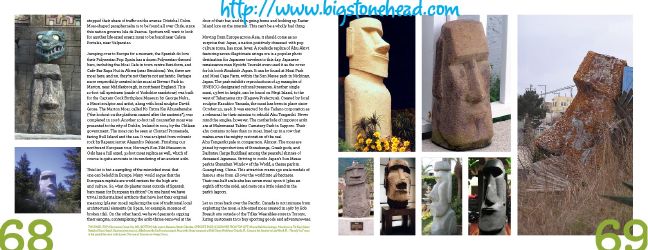Big Stone Head: Easter Island and Pop Culture
Sample pages (blue web address lettering does not appear in the real book!):

An excerpt
109 degrees 30 minutes west longitude.
On a sunny afternoon in April of 1722, the Dutch admiral Jacob Roggeveen and his crew set foot upon dry land for the first time in weeks. They had been searching for an island allegedly spotted five decades earlier by the pirate Edward Davis, an island not seen by any European since Davis made his irreputable report. Upon landing at what was probably Davis' isle, the good captain Roggeveen made note of his discovery. He modestly declined to name the land mass after himself, for this particular date was an important holiday for those of his Christian faith: it was Easter Sunday.
Nothing that the sailors may have dreamed up during the long months of their voyage could possibly have been more unlikely than what they discovered on the rocky shores of the speck of land that their captain had dubbed Easter Island. They encountered a friendly population of a few thousand locals who had been toiling away in complete isolation for more than a millennia, creating about nine hundred immense lava rock statues in tribute to their ancestors. The islanders called their colossal statues moai (which literally translates simply to "figure". The islanders called their home Matakiterangi (or "eyes looking at heaven"; but the names Rapa Nui ("large island", ironically) and Te Pito o te Henua ("The Navel of the World" were later put into more common use.
Certainly, an inveterate impression was made upon Roggeveen and his crew. Imagine their complete sense of surprise and awe at seeing these stoic effigies lined up on massive ceremonial platforms (or ahu) all over the tiny island. With no expectations about what lay ahead, and with absolutely no foreknowledge of the existence of this culture or these remarkable stone giants, the Dutch crew were the first outsiders ever to gaze upon these big stone heads. Stories of the island were circulated across the globe, and it wasn't long before further explorers in Roggeveen's wake made the voyage to Rapa Nui. They brought goods and tales from around the world with them, as well as war, disease, and Christianity; in return they took slaves, stole sacred rongorongo tablets, and even absconded with a few of the twenty-ton moai.
It's been almost three centuries since the first contact between the Rapa Nui and the Dutch, and the powerful and iconic image of the moai has now spread to every point on Earth. There are few civilized people who have never been exposed to the image of the moai in some form. The legend of Easter Island has inspired as many imaginations as the pyramids of Egypt, the discovery of dinosaurs, or the idea of flights to Mars.
Serious scientific study of the island didn't begin until the early 20th century. By then, plague, slave traders, and intertribal warfare had toppled all of the moai from their ahu, and had almost completely wiped out the Rapa Nui population. The current islanders have no knowledge of how the moai they live amongst were erected. The archeologists looking for answers have raised perhaps more questions than satisfying solutions. With almost no trees on the island and no modern construction equipment, how did rock statues between ten and forty feet tall appear and then make their way to various points on the island, erect on their ahu? Who built them and why? Why were they eventually toppled over? What do the indecipherable rongorongo tablets say? And what of the mysterious "birdman" rituals?
These questions and many others have fueled the mythology surrounding remote Easter Island, marking it for some as a mystical and arcane place. This image, in turn, has only reinforced the iconographic image of the moai world wide. Beginning with Roggeveen, and then through the time of Captain James Cook half a century later, and on to visits from Katherine Routledge, William Mulloy, and Thor Heyerdahl in modern times, people from across the globe have made the arduous journey to Rapa Nui, bringing back fantastic impressions of the unique and awe-inspiring stone giants. These impressions have disseminated themselves globally, informing every citizen in the educated world about a little dot in the middle of the southeast Pacific called Rapa Nui, 64 square miles in size, and 2300 miles from the next nearest center of population.
As popular culture and mass media exploded through the 20th century, the instantly recognizable stony visage of the moai has made its way into the consciousness of virtually everyone. These solemn and uncomplaining effigies of dead ariki (clan leaders) have been repurposed by a consumerist culture: from sacred relics of the Rapa Nui people into a marketable icons, free of copyright, for use the world over. Seen by the even casual observer in the most unlikely of places, the moai has become a universal symbol for the unexplained, the exotic, the numinous, the infrangible, the enchanted, and the weird. By the 1940s, Easter Island was being featured in liquor ads, by the 1960s replica moai were standing outside of Las Vegas casinos, and by 2003, the image had devolved into something suitable for use on a tissue box; but somehow the stoic ancestors of Rapa Nui have maintained their dignity through all of this.
But still these nagging questions: why did the islanders spend centuries building the moai? And, centuries after being forsaken by their builders, why are the moai now worshiped, after a fashion, by the population of the rest of the world?
We may discover that neither of these questions has a fully satisfying answer, but the journey itself is often the destination, so journey with me now to Rapa Nui, the navel of the world, where our story begins...
©2009 James Teitelbaum all
rights reserved.